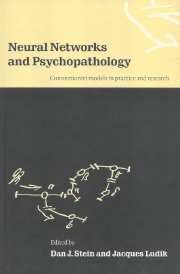Book contents
- Frontmatter
- Contents
- List of contributors
- Preface
- Part one General Concepts
- Part two Clinical disorders
- 7 The nature of delusions: a hierarchical neural network approach
- 8 ‘Produced by either God or Satan’: neural network approaches to delusional thinking
- 9 Neural network modelling of cognitive disinhibition and neurotransmitter dysfunction in obsessive–compulsive disorder
- 10 The fables of Lucy R.: association and dissociation in neural networks
- 11 Neural network analysis of learning in autism
- 12 Are there common neural mechanisms for learning, epilepsy, and Alzheimer's disease?
- Epilogue
- Index
12 - Are there common neural mechanisms for learning, epilepsy, and Alzheimer's disease?
from Part two - Clinical disorders
Published online by Cambridge University Press: 12 January 2010
- Frontmatter
- Contents
- List of contributors
- Preface
- Part one General Concepts
- Part two Clinical disorders
- 7 The nature of delusions: a hierarchical neural network approach
- 8 ‘Produced by either God or Satan’: neural network approaches to delusional thinking
- 9 Neural network modelling of cognitive disinhibition and neurotransmitter dysfunction in obsessive–compulsive disorder
- 10 The fables of Lucy R.: association and dissociation in neural networks
- 11 Neural network analysis of learning in autism
- 12 Are there common neural mechanisms for learning, epilepsy, and Alzheimer's disease?
- Epilogue
- Index
Summary
Introduction
Understanding the neurophysiological mechanisms that support learning and memory remains one of the greatest challenges to science today. A major landmark in this area of study occurred some 20 years ago when Bliss and Lomo (1973) discovered a long-term potentiation (LTP) of synaptic excitability in the dentate area of the hippocampal formation due to a brief, high-frequency stimulation of the perforant path. Since then, LTP has become the leading model for the molecular basis of memory. While there is now a growing taxonomy for LTP classification, this chapter is concerned primarily with N-methyl-D-aspartate (NMDA)-dependent potentiation. Recent research has begun to elucidate the manner in which NMDA-dependent LTP induction leads to functional and morphological changes in synaptic structure and ion channel properties that may serve to maintain the increased potentiation (e.g., Desmond and Levy, 1988; Chen and Huang, 1992).Moreover, malfunction in the development of NMDA-dependent LTP may provide insights into our understanding of certain neurological disorders such as epilepsy and, particularly, Alzheimer's disease, both of which seem to be affected by changes in NMDA receptor activation.
In the popular consciousness, Alzheimer's disease is identified as a disorder of memory function. While research on Alzheimer's disease has produced a range of etiological theories, ranging from the improper splicing of the amyloid precursor protein (Selkoe, 1993) to epidemiological factors such as aluminum exposure (Crapper McLachlan and Van Berkum, 1986) or prions (Goudsmit and Van der Waals, 1986), these etiological theories have not explicitly accounted for why this disorder should show its earlier symptoms as a disorder of memory function (Jolles, 1986; Morris and Kopelman, 1986; Albert et al., 1991)
- Type
- Chapter
- Information
- Neural Networks and PsychopathologyConnectionist Models in Practice and Research, pp. 316 - 344Publisher: Cambridge University PressPrint publication year: 1998
- 1
- Cited by



